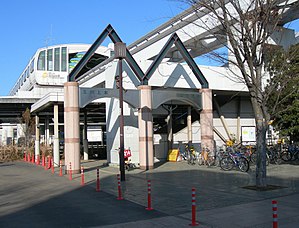Tamagawa-Jōsui Station (玉川上水駅, Tamagawa Jōsui-eki) is a passenger railway station located in the city of Tachikawa, Tokyo, Japan, operated by the private railway operator Seibu Railway, and a monorail station operated by the Tokyo Tama Intercity Monorail in Higashiyamato, Tokyo, Japan. The two stations are adjacent to, and at right angles to one another, with the border between the two cities passing in between the stations. The names of the stations are identical in Japanese, but are transliterated slightly different in romaji such that the Seibu Station is Tamagawa-Jōsui Station, whereas the Tokyo Tama Intercity Monorail is Tamagawajosui Station (i.e. without the hypen or diacritic mark).
Tamagawa-Jōsui Station 玉川上水駅 | |||||
|---|---|---|---|---|---|
 Tamagawa-Jōsui Station | |||||
| General information | |||||
| Location | Tachikawa, Tokyo and Higashiyamato, Tokyo Japan | ||||
| Coordinates | 35°43′55″N 139°25′06″E / 35.731927°N 139.41823°E | ||||
| Operated by |
| ||||
| Line(s) | |||||
| Connections |
| ||||
| |||||
Lines
editTamagawa-Jōsui Station is served by the Seibu Haijima Line, and is 7.2 kilometers from the terminus of that line at Kodaira Station. The monorail station is served by the Tama Toshi Monorail Line and is 1.5 kilometers from the terminus of the line at Kamikitadai Station.
Station layout
editSS33 Tamagawa-Jōsui Station 玉川上水駅 | |||||||||||||||
|---|---|---|---|---|---|---|---|---|---|---|---|---|---|---|---|
| Seibu Railway | |||||||||||||||
| Tamagawa-Jōsui Station platforms | |||||||||||||||
| General information | |||||||||||||||
| Location | 6-36-1 Saiwai-chō, Tachikawa-shi, Tokyo-to 190-0002 Japan | ||||||||||||||
| Operated by | Seibu Railway | ||||||||||||||
| Line(s) | Seibu Haijima Line | ||||||||||||||
| Platforms | 2 island platforms | ||||||||||||||
| Other information | |||||||||||||||
| Station code | SS33 | ||||||||||||||
| Website | Official website | ||||||||||||||
| History | |||||||||||||||
| Opened | May 15, 1950 | ||||||||||||||
| Passengers | |||||||||||||||
| FY2019 | 42,416 | ||||||||||||||
| Services | |||||||||||||||
| |||||||||||||||
Seibu Railway
editThe Seibu station consists of two island platforms served by three tracks.
| 1 | Seibu Haijima Line | for Musashi-Sunagawa, Seibu-Tachikawa, and Haijima |
| 2 | Seibu Haijima Line | Disembarking only |
| 3/4 | Seibu Haijima Line | for Kodaira, Kami-Shakujii, and Seibu-Shinjuku |
Platforms 2 and 3 share the same track. Trains that enter service at this station usually stop at Platform 3.
Tama Toshi Monorail
editTamagawajosui Station 玉川上水駅 | |||||||||||
|---|---|---|---|---|---|---|---|---|---|---|---|
| Monorail | |||||||||||
| Tamagawajosui Exit | |||||||||||
| General information | |||||||||||
| Location | 4-19 Sakuragaoka, Higashiyamato-shi, Tokyo Japan | ||||||||||
| Operated by | Tokyo Tama Intercity Monorail | ||||||||||
| Line(s) | ■ Tama Toshi Monorail Line | ||||||||||
| Platforms | 2 side platforms | ||||||||||
| Other information | |||||||||||
| Station code | TT17 | ||||||||||
| Website | Official website | ||||||||||
| History | |||||||||||
| Opened | 27 November 1998 | ||||||||||
| Passengers | |||||||||||
| FY2019 | 24,696 | ||||||||||
| Services | |||||||||||
| |||||||||||
The elevated station consists of two side platforms served by two tracks.
| 1 | ■ Tama Toshi Monorail Line | for Sakura-Kaidō and Kamikitadai |
| 2 | ■ Tama Toshi Monorail Line | for Tachikawa-Kita, Takahatafudō, and Tama-Center |
History
editThe Seibu station opened on May 15, 1950. The Tama Toshi Monorail station opened on 27 November 1998.[citation needed]
An enclosed waiting room was built on the Haijima Line platform in November 2007.[citation needed]
Station numbering was introduced on the Tama Toshi Monorail Line in February 2018 with its station being assigned TT17.[1]
In celebration of the 10th service anniversary of the Seibu 30000 series "Smile Train" as well as Gudetama's 5th birthday (both in April 2018), one of its 30000 series trains, the station's signboards and waiting areas will adopt the "Gudetama" theme beginning March 2018.[2]
Passenger statistics
editIn fiscal 2019, the station was the 22nd busiest on the Seibu network with an average of 42,416 passengers daily.[3] During the same year, the Tama Monorail reported an average of 24,696 passengers daily.[4]
The passenger figures for previous years are as shown below.
| Fiscal year | Seibu | Tama Monorail |
|---|---|---|
| 2005 | 17,934 | 8,652[5] |
| 2010 | 19,649 | 10,205[6] |
| 2015 | 21,024 | 11,288[7] |
Surrounding area
editThe station area is a mix of residential apartment blocks and commercial buildings. Tamagawa-Jōsui, the source waterway of the Tama River, flows to the south of the station. The Risshō Kōsei Kai Kōsei cemetery is a short walk northwest.
The former Yamato Air Station (大和基地), used by the U.S forces after the end of the second world war, was on the land adjacent (northeast) of the station. A commemorative monument for the base is located a short distance from the (monorail) station's east exits.[8]
See also
editReferences
edit- ^ "多摩モノレール全駅に「駅ナンバリング」を導入します!!" ["Station numbering" will be introduced at all stations on the Tama Monorail!!] (PDF). tama-monorail.co.jp (in Japanese). 30 June 2017. Archived from the original (PDF) on 9 March 2022. Retrieved 9 October 2022.
- ^ "「ぐで玉川上水駅」誕生! ホーム待合室も「ぐでたま」デザインに 西武". 29 March 2018.
- ^ 駅別乗降人員(2019年度1日平均 [Average daily station usage figures (fiscal 2019)] (PDF) (in Japanese). Japan: Seibu Railway. Retrieved 6 January 2021.
- ^ “駅別乗降人員(一日平均)- 多摩モノレール [Persons boarding / alighting by station (daily average) -Tama Monorail] (PDF) (in Japanese). Japan: Tama Monorail. Retrieved 6 January 2021.
- ^ 東京都統計年鑑 平成17年 9 運輸及び通信 [Tokyo Metropolitan Government statistics (fiscal 2005)] (in Japanese). Japan: Tokyo Metropolitan Government. Retrieved 26 March 2021.
- ^ 駅別乗降人員 2010(平成22)年度 1日平均 [Average daily station usage figures (fiscal 2010)] (PDF) (in Japanese). Japan: Seibu Railway. Archived from the original (PDF) on 26 June 2011. Retrieved 22 August 2014.
- ^ 東京都統計年鑑 平成27年 9 運輸及び通信 [Tokyo Metropolitan Government statistics (fiscal 2010)] (in Japanese). Japan: Tokyo Metropolitan Government. Retrieved 26 March 2021.
- ^ 米軍大和基地の碑 Retrieved March 31, 2018 (in Japanese)
External links
editMedia related to Tamagawajōsui Station at Wikimedia Commons
- Tamagawa-Jōsui Station information (Seibu Railway) (in Japanese)
- Tamagawa-Jōsui Station information (Tama Monorail) (in Japanese)

